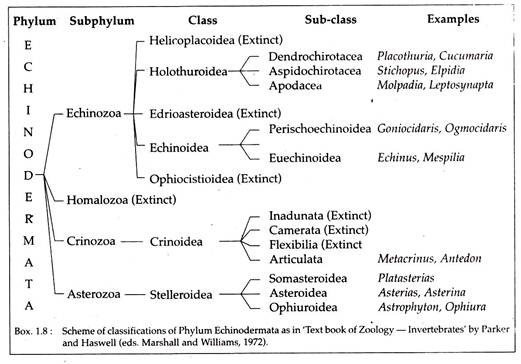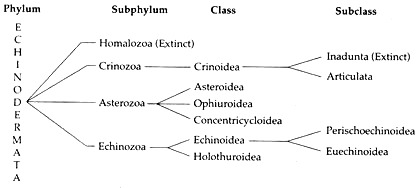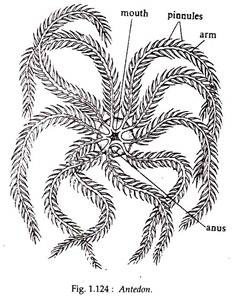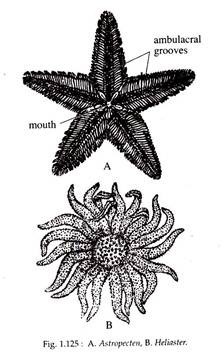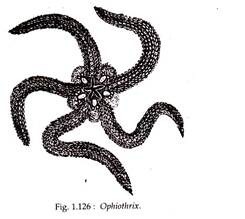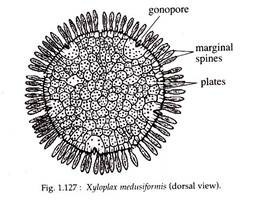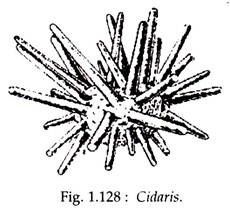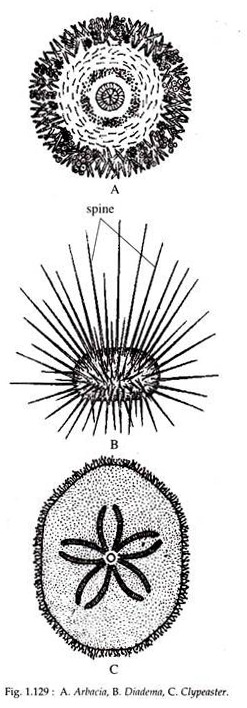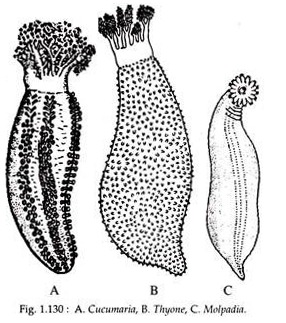In this article we will discuss about Phylum Echinodermata:- 1. Classification of Phylum Echinodermata 2. Diagnostic Features of Phylum Echinodermata 3. Scheme of Classification 4. Systematic Resume.
Classification of Phylum Echinodermata:
Phylum Echinodermata consists exclusively of marine animals, with some being the most beautiful of all sea-creatures. It contains about 6,750 living species (Barnes et al., 1993) and the diversity of echinoderms are much lower now than it was in the Palaeozoic.
Echinoderms are distinguished by a pentamerous radial symmetry, an endoskeleton of calcareous ossicles, a water-vascular system of coelomic canals and soft body appendages, the tube feet used in feeding and locomotion. Another unique feature is the presence of bilateral symmetry in the larva.
Etymology:
ADVERTISEMENTS:
Greek: echinos, hedgehog; derma, skin.
Diagnostic Features of Phylum Echinodermata:
i. Exclusively marine forms.
ii. Adults with radial and five-rayed symmetry while the larvae are bilaterally symmetrical.
iii. Body distinguishable into oral and aboral surfaces and are without any differentiated head.
ADVERTISEMENTS:
iv. The surface of the body is covered by calcareous ossicles or plates, often bearing projecting tubercles or spines.
v. On the underside are five grooves called ambulacra, radiating from the mouth to the tip of the arms, with intervening inter-ambulacra.
vi. Basically with oligometric, tripartite paired enterocoelic body cavities, the metacoels (‘somatocoels’) forming the main body cavity; in a few forms the body cavities are formed schizocoelically.
vii. Digestive canal is mostly a coiled tube with the anus placed on the aboral side.
ADVERTISEMENTS:
viii. A characteristic water vascular system derived mainly from the left mesocoel (left ‘hydrocoel’) and partly from the left protocoel (left ‘exocoel’) is present, which performs many functions.
ix. Presence of tubular contractile tube feet or podia used as locomotory organ and/or feeding organ.
x. Haemal circulatory system poorly defined.
xi. There are no definite respiratory and excretory systems.
xii. Nervous system sub-epidermal, in the form of a circumoesophageal ring from which arises diffused nerve along each ambulacrum.
xiii. Usually gonochoristic. Reproduction is sexual. Gonads simple in nature. Fertilization external.
xiv. Eggs cleave radially.
xv. Development deuterostomatous, characteristically indirect via ciliated, bilaterally symmetrical,’ free swimming larval forms.
Scheme of Classification of Phylum Echinodermata:
ADVERTISEMENTS:
The name Echinodermata was first coined by Jacob Klein in 1734. Later in 1801 Lamarck classified these group of animals.
The scheme of classification presented here is based on the classificatory plan outlined by Ruppert and Barnes, 1994.
Systematic Resume of Phylum Echinodermata:
Subphylum Homalozoa (extinct)
Paleozoic echinoderms lacking any evidence of radial symmetry.
Subphylum Crinozoa:
i. Radially symmetrical, possessing a cup- shaped theca and 5-10 brachioles or arms.
ii. Mostly attached, with oral surface directed upwards, which contains both mouth and anus.
iii. Madreporite absent.
iv. The cup shaped aboral side is called calyx.
Class Crinoidea (Greek: lily-like):
i. Stalked and free moving forms, the oral side of the body directed upwards.
ii. Arms branched (10 to 200 or more) and bearing pinnules.
iii. The ambulacral grooves radiate from the mouth and extend to the tip of the pinnules.
iv. Absence of ampullae to operate the podia.
v. In the absence of the madreporite the numerous stone canals open into the somatocoels.
vi. Presence of a non-contractile aboral stalk, often bearing whorls of cirri, terminating in a disc for attachment.
vii. The arms, body and stalk contain heavily calcified plates.
Subclass Inadunta (Extinct):
Stalked paleozoic crinoids with or without cirri and some without pinnules.
Subclass Articulata:
i. Stalked or stalk less.
ii. With or without cirri.
It comprises of extinct as well as living crinoids;
Examples:
Antedon (stalkless) (Fig. 1.124), Metacrinus (with cirri), Rhizocrinus (without cirri).
Subphylum Asterozoa:
i. Radially symmetrical having a body composed of a flattened disc and radially arranged arms.
ii. Body star shaped and remains unattached.
iii. On the oral surface in the ambulacral groove, tube feet are present.
Class Asteroidea (Greek: star-like):
i. Arms not sharply set off from the central disc.
ii. Ambulacral grooves are open and a large coelomic cavity is present in the arms.
iii. Each ambulacral groove contains two or four rows of tube feet.
iv. Tube feet with or without suckers.
v. Anus and madreporite are present on the aboral surface.
Examples:
Asterias (Fig. 1.131), Astropecten (Fig. 1.125A), Heliaster (Fig. 1.125B), Platyasterias, Asterina.
Class Ophiuroidea (Greek: snake-like):
i. Arms sharply set off from the central disc.
ii. Absence of ambulacral groove and the arms are filled by vertebral ossicles.
iii. No spacious prolongations of the coelom into the arms.
iv. Mouth and madreporite are situated on the oral surface of the body.
v. Anus lacking.
Examples:
Ophiura, Ophiothrix (Fig. 1.126), Ophioderma, Ophionereis, Asteronyx.
Class Concentricycloidea (Latin: concentric ring):
i. Minute, with disc shaped body.
ii. Body covered aborally with plate like ossicles.
iii. Marginal spines are located around the periphery.
iv. Water vascular system has two ring canals with the tube feet arising from the outer one.
v. Absence of arms but the passage of tube feet between ossicles ‘are like those of stelleroidea.
Examples:
Xyloplax medusiformis (Fig. 1.127) , Xyloplax turnerae.
These animals were collected and identified in 1983 and 1984.
Subphylum Echinozoa:
i. Radially symmetrical, globoid or discoid, without arms or brachioles.
ii. Remains unattached.
iii. Madreporite and anus remain on the aboral side.
iv. Mouth present on the oral surface.
Class Echinoidea (Greek: spiny):
i. Body more or less spherical, flattened orally/aborally.
ii. Ossicles fused to form an internal test on which moveable spines are mounted.
iii. Although the ambulacral grooves are absent, the body surface is divided into alternate ambulacral and inter-ambulacral areas.
iv. The ambulacral areas extend from the oral to the aboral sides of the body.
v. Ambulacral plates have pores for the passage of the tube feet.
vi. The tube feet possess suckers.
Subclass Perischoechinoidea:
i. Of the four orders of this subclass, cidaroida is the only one present today which possesses two rows of plates for each ambulacrum and inter-ambulacrum.
ii. Presence of widely separated primary spines and small secondary spines.
iii. Gills absent.
Examples: Cidaris (Fig. 1.128), Notocidaris, Eucidaris
Subclass Euechinoidea:
i. Test present which may be rigid or flexible, flattened or round to oval.
ii. Spines may be hollow or solid.
iii. Aristotle’s lantern, a highly developed scraping apparatus used in feeding, is mostly present.
iv. Gills usually present.
Examples:
Echinus, Arbacia (Fig. 1.129A), Clypeaster (Fig. 1.129C), Diadema (Fig. 1.129B).
Class Holothuroidea (Greek: violent expulsion)
i. Body elongated along the oral/aboral axis.
ii. The surface of the body may exhibit five ambulacral areas.
iii. Mouth and anus present at opposite extremities of the body.
iv. Oral podia modified as tentacles which may be simple or dendritic and may or may not be provided with ampullae.
v. Skeleton reduced to microscopic ossicles.
Examples:
Holothuria, Cucumaria (Fig. 1.130A), Thyone (Fig. 1.130B), Molpadia (Fig. 1.130C).
